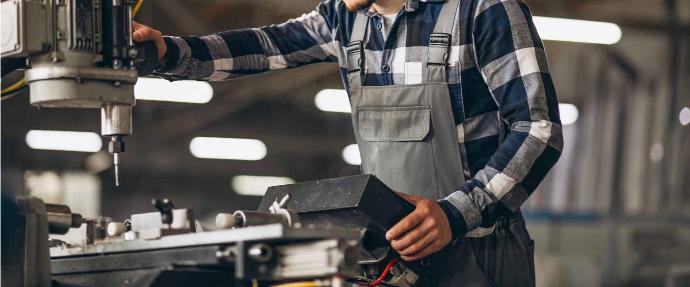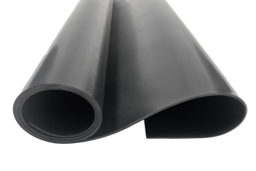A Complete Guide to Neoprene Rubber
What is Neoprene Rubber?
Neoprene rubber, also known as Polychloroprene, is a man-made synthetic rubber. It is one of the most versatile materials available for manufacturing rubber products as its properties demonstrate excellent chemical stability and resistance to UV and weathering. It is also tough, abrasion resistant and can operate in a wide temperature range.
With over 70% of the rubber used for manufacturing rubber products being synthetic, a large proportion of this is Neoprene. It is available as solid Neoprene or expanded Neoprene (open-cell sponge or closed-cell sponge) in a range of hardnesses and densities.
This guide details the history of Neoprene and explains the main advantages and disadvantages of using this rubber compound for manufacturing bespoke sealing solutions.
How is Neoprene Rubber Made?
When demand for natural rubber exceeded supply, scientists looked to develop a low cost synthetic alternative. In 1930 DuPoint purchased a patent focused on acetylene chemistry. This research discovered that a jelly-like substance called divinyl acetylene, when combined with sulfur dichloride, set into an elastic compound similar to natural rubber. DuPoint continued this research and later developed the synthetic rubber compound known as Neoprene.
Today, the process of manufacturing Neoprene remains almost completely unchanged. Neoprene is created using a process called polymerisation which is a chemical reaction that creates by-products. These by-products are melted, mixed with carbon pigments and foaming agents and then baked. This process creates a Neoprene rubber compound.
The raw compound can then be used to create rubber Neoprene seals, such as extruded profiles or moulded gaskets. The extrusion process pushes the rubber compound through a tool (known as a die) which, together with pressure and temperature, extrudes the required shape. This compound can also be used to produce rubber strip or sheet for sealing, edging and cushioning applications. Large calendar rollers squash the raw compound into flat sheets which are then cut to the required thickness, width and length.
Although the Neoprene rubber compound is initially semi-solid, it can be made into both solid rubber and expanded sponge rubber products. During manufacturing, nucleating agents such as nitrogen or carbon dioxide are added to the compound to create a cellular structure. The gas injection rate can be adjusted to help achieve different densities and properties. This process creates what is known as expanded Neoprene, a closed-cell sponge that is often used to create watertight seals.
Advantages of Neoprene Rubber
Neoprene is a popular general purpose material that has been reliably used to manufacture Neoprene seals, trims and gaskets for many years. It demonstrates an excellent resistance to weathering, most substances and extreme environments making it the material of choice for sealing solutions in most industry sectors. These properties include;
- Weathering:
Neoprene has superb weathering properties which make it an excellent material
for seals and trims used in outdoor environments. These properties make
Neoprene waterproof and resilient to UV when exposed to direct sunlight, and
suitable for use in the marine environment where products need to demonstrate
excellent ozone resistance. Neoprene, in both its sponge and solid forms, also
has a low oxidation rate so will not absorb moisture.
- Chemical
Resistance: Although harsh chemicals will degrade the rubber with prolonged
exposure, Neoprene demonstrates a fair resistance to splashes and light contact
with most chemicals, fuels and oils. It can also withstand contact with some
alkaline solutions and methyl or ethyl alcohols.
- Temperature Range: Rubber seals manufactured from Neoprene maintain a similar hardness and flexibility in low and high temperature environments. Although these products will provide a good sealing solution in temperatures between -20°C to +90°C without deforming, cracking or splitting, it is recommended that seals manufactured in Neoprene are used in temperatures above 0°C.
During a test which heated Neoprene to 70°C for 70 hours,
there were no changes to the materials hardness or elongation. There was only a
minor (+9%) change to its tensile strength.
As well as demonstrating excellent weathering and good general resistance, a Neoprene seal displays exceptional functional characteristics which make it an ideal material for a wide selection of automotive, marine and industrial sealing applications. These characteristics include;
- Resilient:
Unlike some other synthetic rubber compounds, rubber seals manufactured in
Neoprene are incredibly durable and less prone to tearing or abrasion. The material
does not easily stretch reducing the chance of damaging the seal during
installation. These factors, in addition to Neoprene rubbers' general weathering
and resistance, allow you to purchase a long lasting sealing solution that will
not need replacing for a considerable amount of time.
- Cost
Effective: As Neoprene is used as the base material for a diverse variety
of products, it is manufactured in high volumes at a relatively low cost.
Compared with other rubber compounds such as natural rubber and Nitrile, Neoprene
is an affordable alternative with similar operating properties. As rubber seals
manufactured in this material are strong, hardwearing and resistant to abrasion
they need to be less frequently replaced. The initial low production cost
together with the extended durability makes Neoprene an affordable option for
most sealing solutions.
- Self-Extinguishing:
Neoprene rubber is self-extinguishing which allows it to burn when in direct
contact with a flame but instantly self-extinguishes as soon as the flame is
removed. It can also be manufactured in a fire retardant compound with low
smoke and toxicity characteristics.
- Vibration
Dampening: Rubber seals and gaskets
manufactured in Neoprene are able to dampen vibrations and shock. The structure
of the material can flex when force is applied dissipating and absorbing the
vibration. This allows the rubber to be used in applications containing
equipment that needs to be protected from vibrations caused by impact.
- Closed-Cell: One variant of Neoprene is expanded sponge Neoprene which is a closed-cell sponge that does not absorb water. In a similar way to compressible foam, it can be used to create watertight seals on hatches, doors and lockers. Similar to solid Neoprene, expanded Neoprene can be extruded or cut into an endless variety of shapes and sizes.
Disadvantages of Neoprene Rubber
Although Neoprene is an excellent material for most sealing applications, there are occasions where it would be better to use an alternative rubber compound such as Silicone or Nitrile. These include;
- Extreme
Temperatures: Whilst Neoprene seals can be used in temperatures between -20°C to +90°C, the optimum temperature
range is 0°C to +70°C. This makes it unsuitable for freezer cabinets, ovens and
autoclaves. Sealing solutions for these products should be manufactured from a
material such as Silicone which can withstand much lower and higher temperature ranges.
- Chemical Resistance: Constant contact or submersion with certain hydrocarbons, strong oxidising acids or esters and ketones will cause the rubber to degrade. For applications where the rubber seal will be in contact with these substances, you should use a Nitrile or Viton extrusion or gasket.
Common Applications and Uses
As Neoprene is an incredibly durable and versatile material it is ideal for a large variety of rubber sealing products. These products are relatively easy to extrude or cut, and can be manufactured from both solid Neoprene and expanded Neoprene. Although it is best to choose a material based on what substances it may come into contact with, Neoprene as a general-purpose rubber compound is commonly supplied to the following industries for use in the manufacturing or restoration of their vehicles and products.
Industries

Automotive
A number of rubber seals manufactured for the automotive industry are extruded using either solid or sponge Neoprene. Although a lot of these products have been replaced with EPDM alternatives, Neoprene is still used to manufacture some door seals and trims. These rubber seals can be used on parts of the vehicle that will not come into contact with large amounts of fuel.
Another common benefit of Neoprene rubber is its ability to absorb vibrations and shock. This makes it ideal for automotive applications where the seal will be subjected to vibrations originating from the engine or road.

Engineering and Industrial
Similar to EPDM, Neoprene is a suitable material to manufacture most general purpose rubber seals, trims and gaskets within the engineering, industrial, construction and fabrication industry sectors.
As a weather resistant material,
it can be used with confidence in an outdoor environment without the risk of
deterioration from UV exposure or direct sunlight.

Marine
Perhaps the most common application for Neoprene rubber is in the production of wetsuits. This application demonstrates how the material can be used within the marine environment without any issues with long-term performance.
As a solid or closed-cell sponge, Neoprene does not absorb water so can create a sealing solution that stops any potential water ingress. It is also UV stable and ozone resistant so will not degrade in the direct sunlight.
Types and Grades of Neoprene Rubber
Neoprene rubber is available in a selection of types and grades suitable for different uses and industries. As a material that can be manufactured into both sponge and solid variants, Neoprene offers a solution to most sealing applications. It can be blended with other rubber compounds, such as SBR and EPDM, to reduce the cost and improve resistance and stability.

Commercial Grade Neoprene Rubber
Commercial grade Neoprene rubber is a general purpose product that offers all of the properties of Neoprene, including a good general resistance to most substances and weathering. It is often blended with other rubber compounds, such as SBR to reduce the price. It is available in a range of hardnesses from 40°sh A to 80°sh A.

Neoprene Rubber to British Standard BS2752
Neoprene
is also available in a grade compliant with British Standard BS2752
specifications. This compound uses a higher content of Neoprene rubber to
improve its weathering properties and chemical resistance. It is available in a
selection of shore hardnesses, including C40, C50, C60, C70 and C80.

Expanded Neoprene / EPDM Closed-Cell Sponge Rubber
Neoprene is also available as a closed-cell sponge which can be used to create watertight seals to stop water ingress. Expanded Neoprene is often blended with EPDM to reduce the price and improve its UV stability and chemical resistance. It can be purchased in a range of different profile shapes in hardnesses between 50kg/m3 to 190kg/m3.

Fire Retardant Neoprene Rubber
Although fire retardant Neoprene (EN45545-2) is more expensive than commercial grades, it is often a requirement for mass transport systems. This material has low smoke and low toxicity characteristics which help provide a safe environment in enclosed environments.
Contact Us
With over 50 years' experience in the rubber sealing industry, our team has extensive experience in finding sealing solutions for our customers. Contact our experts via phone or email for sealing advice or bespoke quotations.
Email:
sales@sealsplusdirect.co.uk
Telephone:
01425 617722